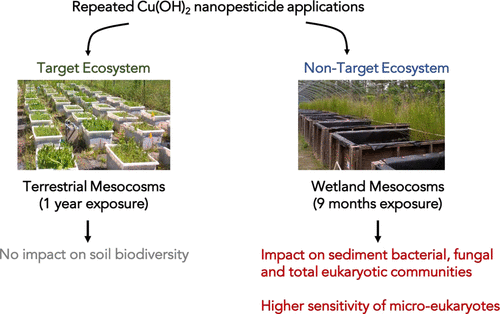当前位置:
X-MOL 学术
›
Environ. Sci. Technol.
›
论文详情
Our official English website, www.x-mol.net, welcomes your feedback! (Note: you will need to create a separate account there.)
Long-Term Effects of Copper Nanopesticides on Soil and Sediment Community Diversity in Two Outdoor Mesocosm Experiments.
Environmental Science & Technology ( IF 11.4 ) Pub Date : 2020-06-16 , DOI: 10.1021/acs.est.0c00510 Lauren N Carley 1, 2 , Renuka Panchagavi 3 , Xin Song 4, 5 , Sade Davenport 3 , Christina M Bergemann 1, 6 , Alexander W McCumber 7 , Claudia K Gunsch 6, 7 , Marie Simonin 1, 6, 8
Environmental Science & Technology ( IF 11.4 ) Pub Date : 2020-06-16 , DOI: 10.1021/acs.est.0c00510 Lauren N Carley 1, 2 , Renuka Panchagavi 3 , Xin Song 4, 5 , Sade Davenport 3 , Christina M Bergemann 1, 6 , Alexander W McCumber 7 , Claudia K Gunsch 6, 7 , Marie Simonin 1, 6, 8
Affiliation

|
The use of novel pesticides containing nanomaterials (nanopesticides) is growing and is considered a promising approach to reduce the impacts of agriculture on the environment and human health. However, the environmental effects of these novel agrochemicals are not fully characterized, and more research is needed to determine the benefits and risks they confer. Here, we assessed the impacts of repeated exposures to a Cu(OH)2 nanopesticide on the soil and sediment biodiversity of target (terrestrial) and nontarget (wetland) ecosystems by performing long-term outdoor mesocosm experiments. As pesticides are often used concomitantly with other agrochemicals, we also tested for interactive effects between nanopesticide exposure and fertilization treatments in both ecosystems. We used high-throughput sequencing on three marker genes to characterize effects on bacterial, fungal, and total eukaryotic community structure and diversity. Interestingly, we found limited effects of nanopesticide exposure on the terrestrial soil communities. Conversely, we found significant shifts in the sediment communities of the wetland mesocosms, especially for eukaryotes (protists, fungi, and algae). In the absence of fertilization, fungal and total eukaryotic community compositions exposed to nanopesticides for long periods of time were distinct from unexposed communities. We identified 60 taxa that were significantly affected by nanopesticide exposure, most of which were microeukaryotes affiliated to cercozoans, Gastrotricha, or unicellular algal taxa. Our study suggests that this nanopesticide has limited effects on the soil biodiversity of a target terrestrial agroecosystem, while nontarget aquatic communities are more sensitive, particularly among protists which are not targeted by this bactericide/fungicide.
中文翻译:

在两个室外中观试验中,纳米铜农药对土壤和沉积物群落多样性的长期影响。
含有纳米材料(纳米农药)的新型农药的使用正在增长,被认为是减少农业对环境和人类健康影响的有前途的方法。但是,这些新型农用化学品的环境影响尚未完全特征化,需要更多研究来确定它们带来的利益和风险。在这里,我们评估了反复暴露于Cu(OH)2的影响通过进行长期的室外中观试验,将纳米农药用于目标(陆地)和非目标(湿地)生态系统的土壤和沉积物生物多样性。由于农药通常与其他农药一起使用,因此我们还测试了两种生态系统中纳米农药暴露与施肥处理之间的相互作用。我们对三个标记基因使用了高通量测序,以表征对细菌,真菌和总真核生物群落结构和多样性的影响。有趣的是,我们发现纳米农药暴露对陆地土壤群落的影响有限。相反地,我们发现湿地中观的沉积物群落发生了显着变化,特别是对于真核生物(原生生物,真菌和藻类)。没有施肥 长时间暴露于纳米农药的真菌和总真核生物群落组成与未暴露的群落不同。我们确定了60种受纳米农药暴露影响显着的分类单元,其中大多数是与真尾类动物,胃类或单细胞藻类相关的微真核生物。我们的研究表明,这种纳米杀虫剂对目标陆地农业生态系统的土壤生物多样性影响有限,而非目标水生生物群落则更为敏感,尤其是在未被该杀菌剂/杀真菌剂作为目标的原生生物中。
更新日期:2020-07-21
中文翻译:

在两个室外中观试验中,纳米铜农药对土壤和沉积物群落多样性的长期影响。
含有纳米材料(纳米农药)的新型农药的使用正在增长,被认为是减少农业对环境和人类健康影响的有前途的方法。但是,这些新型农用化学品的环境影响尚未完全特征化,需要更多研究来确定它们带来的利益和风险。在这里,我们评估了反复暴露于Cu(OH)2的影响通过进行长期的室外中观试验,将纳米农药用于目标(陆地)和非目标(湿地)生态系统的土壤和沉积物生物多样性。由于农药通常与其他农药一起使用,因此我们还测试了两种生态系统中纳米农药暴露与施肥处理之间的相互作用。我们对三个标记基因使用了高通量测序,以表征对细菌,真菌和总真核生物群落结构和多样性的影响。有趣的是,我们发现纳米农药暴露对陆地土壤群落的影响有限。相反地,我们发现湿地中观的沉积物群落发生了显着变化,特别是对于真核生物(原生生物,真菌和藻类)。没有施肥 长时间暴露于纳米农药的真菌和总真核生物群落组成与未暴露的群落不同。我们确定了60种受纳米农药暴露影响显着的分类单元,其中大多数是与真尾类动物,胃类或单细胞藻类相关的微真核生物。我们的研究表明,这种纳米杀虫剂对目标陆地农业生态系统的土壤生物多样性影响有限,而非目标水生生物群落则更为敏感,尤其是在未被该杀菌剂/杀真菌剂作为目标的原生生物中。



























 京公网安备 11010802027423号
京公网安备 11010802027423号